
The One Day format of International Cricket can safely be assumed to be an intriguing affair that relies on skills and techniques generally associated with its predecessor (Tests) and successor (T20is). While ODI cricket demands keen observation, understanding, and spot on strategizing just like Test cricket, it also requires a fair amount of slogging and power hitting in the crunch overs just like T20s.
Over 4000 ODIs have been played since the first official ODI was contested between Australia and England on 5th January 1971.
While the format has given the fans countless memories, nail-biting finishes and the chance to witness rivals challenging each other in a series of competitive matches, there have been certain moments that have left a lasting impression on a fan's mind.
It is therefore not too difficult to believe that there have also been certain one-sided matches over the course of ODI history.
While one-sided encounters is a term used in a broader sense, we can try to narrow it down so that we only talk about matches contested between 2 heavily mismatched sides on a given day.
Let us take a look at a few instances where one side was completely outplayed by their counterparts.
#5 West Indies vs Pakistan (25 February 1993)
Pakistan: 43 all out
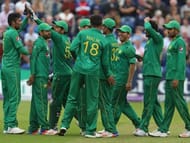
This match was contested as part of the Total International Series in South Africa in 1993. The tri-nation tournament was played between the home side South Africa, West Indies and Pakistan.
The ninth match of the tournament served as an absolute shocker for the fans as well as for the experts neither of whom could have fathomed the result of the match.
The result of the penultimate match of the tournament did not have any impact on the team's standing on the points table meaning that both these teams had already made it to the final of the tournament.
That does not take anything away from the WI bowling masterclass that dented and obliterated the Pakistani batting. West Indies won the toss and elected to field first on a grassy wicket at Cape Town.
The Pakistan team found themselves in a pickle after their opening batsman Rameez Raja was dismissed on the very first ball of the innings from Patrick Patterson. Young Saeed Anwar then walked out to the middle to support Ghulam Ali. The duo could only add 10 more runs to the total as Anwar had to walk back to the pavilion after poking at a Walsh delivery that bounced a little more than expected. The experienced Salim Malik looked particularly distraught after his dismissal left the team tottering at 14/4.
Pakistan's hope of recovering was all but over when 5 of their batsman had registered ducks in succession. 26/9 is not the sort of situation you want to be in as a batting side.
The last wicket partnership of 17 runs between Zahid Fazal and Aaqib Javed offered little to no respite to the Pakistanis. Zahid Fazal was the top scorer with 21.
For West Indies, Courtney Walsh was the pick of the bowlers with figures of 4/16.
West Indies cruised home to victory inside of 13 overs with 7 wickets in hand. They had dominated Pakistan in the previous 2 encounters of the tournament and this victory coupled with their crowning glory just made the difference between the 2 sides conspicuous.
#4. Sri Lanka vs South Africa (11 January 2012)
Sri Lanka: 43 all out
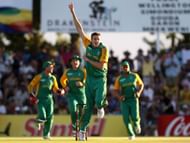
The 3 Test series preceding the five-match ODI series in Sri Lanka's 2011/12 tour to South Africa had been won by the hosts 2-1. AB de Villiers had hit the purple patch and ended up being the leading run scorer in the Test series with 359 runs.
He looked in great nick and it was now time for him to show his skills in the limited overs format.
South Africa won the toss and elected to bat first in the first ODI at Paarl.
They lost Graeme Smith early with only 9 runs on the board. Jacques Kallis then combined with Hashim Amla to stitch together an excellent second wicket partnership of 142 runs in 25 overs. After Kallis, it was ABD who expedited the run rate by scoring a quickfire half-century giving perfect company to the centurion Amla at the other end. Late hitting from Albie Morkel propelled the total to 301/8 in the allotted 50 overs.
Lasith Malinga managed to bag a fifer while conceding 54 runs in his quota of 10 overs.
Sri Lanka had a nightmarish start to their innings losing both their openers for only 4 runs on the board. Dinesh Chandimal and the dependable Sangakarra could not do much as they could each manage only 4 runs. The captain's dismissal only brought a sense of despair along with it into the dressing room.
After Tsotsobe, it was now time for Morne Morkel to chance his arm. He dismissed Angelo Matthews for 0 to expose the Sri Lankan lower middle order.
Former captain Mahela Jayawardene also couldn't do anything to prevent his side's condition from deteriorating. Kosala Kulasekara was the only batsman to score in double figures, scoring 19.
Morne Morkel's 4/10 and Lonwabo Tsotsobe's 3/19 ensured that SL never fully recovered after losing their top 5 batsmen.
South Africa registered a thumping victory over Sri Lanka by 258 runs.
#3. Zimbabwe vs Sri Lanka (8 December 2001)
Zimbabwe: 38 all out
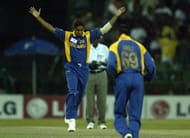
The first match of the LG Abans Triangular Series in Sri Lanka will always be remembered for two things.
The first being Chaminda Vaas's ODI career-best bowling figures of 8/19 and the second, the length of the match both in terms of the total number of overs played and the duration of the contest.
The discipline and swing with which Vaas bowled on that day decimated the Zimbabwean batting beyond doubt. Sri Lanka won the toss and elected to bat first on a surface with a bit of grass top but not the sort hiding demons beneath it. Dion Ebrahim’s one delivery stay at the crease triggered a collapse that allowed a lot of policemen on duty some much needed time to rest.
Grant Flower and Stuart Carlisle’s double-digit partnership of 11 runs came to an end when one-half of the Flower brothers had his stumps rattled. Andy Flower followed his brother to the dressing room after just 2 deliveries.
Craig Wishart was trapped in front with the score reading 27/5 leaving little room for any fightback. The score quickly fell from 27/6 to 32/8 with Vaas being responsible for each one of those 8 dismissals. Muttiah Muralitharan was asked to bowl the 16th over. The Lankan legend wasted no time by picking the last 2 wickets in just 4 balls conceding a single in the process.
The Zimbabwe scorecard read 38/10, which meant that they had underperformed and registered the then lowest ODI team total.
Vaas had bowled the best spell of his ODI career. Sri Lanka chased the target in just 4.2 overs in 2 hours since the start of play.
#2. Canada vs Sri Lanka (19 February 2003)
Canada: 36 all out
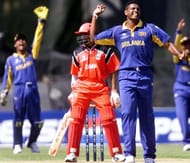
The 18th match of the ICC Cricket World Cup 2003 was contested between Canada and Sri Lanka at Paarl. Sri Lanka was one of the top contenders to qualify for the knockouts stage of the tournament while Canada had the daunting task of scoring a respectable total against the Lankan Lions.
Sri Lanka won the toss and elected to bowl first. Desmond Chumney opened the innings for Canada alongside John Davison. Unlike the first ball dismissal that had occurred on most of the previous instances of this list, the Canadian team registered a 10 ball 0 run first wicket partnership. Desmond Chumney’s 25 balls 9 came to an end soon after and pushed his side into a precarious looking 11/3.
3 further wickets fell without any addition to the team total of 12 runs in the form of Billcliff, NA de Groot and Maraj.
Ashish Bagai and Thuraisingam’s individual contributions of 6 runs each couldn’t do much to change the course of the game. The last wicket of Austin Codrington came on the fourth ball of the 19th over, signalling the end of dismal team performance.
For Sri Lanka, Prabath Nissanka returned with the best bowling figures of 4/12.
It was just a matter of time before Sri Lanka pounced on the inexperienced Canadian bowling attack to overhaul the target inside of 5 overs.
#1. Zimbabwe vs Sri Lanka (25 April 2004)
Zimbabwe: 35 all out
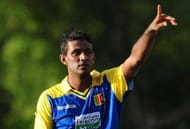
3 years after the drubbing the Zimbabweans had received at the hands of the Lankans, the 2 sides were competing against each other in the third ODI of the 5 matches bilateral series.
Sri Lanka had already won the first 2 matches and was inching closer towards a series victory.
Zimbabwe, on the other hand, had followed a competitive valiant effort in the first ODI by a dispirited performance in the second ODI.
Sri Lanka won the toss and elected to field first at Harare. Matsikenyeri was run out on the second ball of the fourth over with the score reading just 5 runs.
Dilhara Fernando was tantalizingly close to getting a hat trick when he managed to get rid of Dion Ebrahim and Tatenda Taibu on consecutive deliveries of the eighth over. Vaas then joined the action by rattling the furniture on 2 separate occasions by dismissing Elton Chigumbura and Maregwede inside of 13 overs.
After Fernando and Vaas, it was now Farveez Maharoof’s time to take the center stage. First, he dismissed Vusi Sibanda for 4, pushing Zimbabwe on the brink of uncertainty at 27/7. He followed it up by claiming the last 2 wickets in the space of 3 deliveries in the 18th over of the Zimbabwean innings.
The humiliation just seemed to pile on for Zimbabwe as they had hit an all-time low by scoring the lowest team total in ODIs to date at 35 all out. Chaminda Vaas once again was the star of the show finishing with figures of 4/11.
Sri Lanka marched towards an emphatic victory, scoring 40/1 inside of 10 overs.
Looking for fast live cricket scores? Download CricRocket and get fast score updates, top-notch commentary in-depth match stats & much more! 🚀☄️
